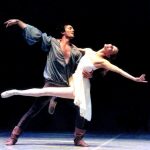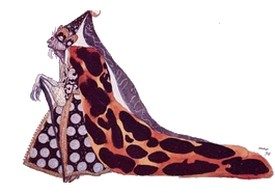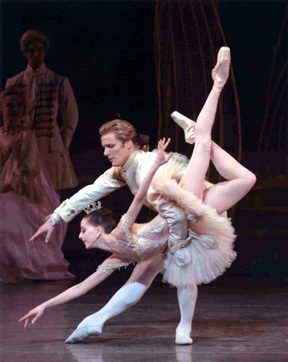Bedtime stories: The Sleeping Beauty
The Sleeping Beauty is a ballet telling the famous tale of the Princess Aurora that gets cursed by the evil fairy Carabosse and saved by the noble Prince Désiré (why do they always have to give the guys so hilarious names? What’s wrong with Bob?)
You all know the story, right, so let’s be brief.
The story starts with King Florestan the XXIVth (you see? Silly names, all over. And thats 24th, for those of you a little rusty on roman numbers), who is holding a grand christening ceremony for his newborn daughter, Princess Aurora. He invites no less than six fairies to be godmothers. I’m not going to name them all here, but it involves characters like the Singing Canary-fairy and the fairy of Falling Breadcrumbs… Lead by the gorgeous Lilac Fairy, the six are there to present little Aurora with gifts of beauty and wealth and all what a little baby can imagine. But as doing that, they are interrupted by the entrance of the wicked fairy Carabosse, furious because she wasn’t invited for the ceremony. With spite, Carabosse curses the little one, predicting that on her sixteenth birthday, she will prick her finger, and die. Fortunately, the Lilac Fairy did not yet give Aurora her gift. She is not able to break the spell, Carabosse’s power is too strong for that. She does manage to change it a little though. Aurora will indeed prick her finger. But she will not die, rather fall in a deep sleep, only to be awaken by the kiss of a prince.
The original sketch for the evil fairy Carabosse, by Leon Bakst
Allright! Such action! And that’s just the prologue. The tale can begin.
First act starts on the next happening worth mentioning in the tale, I guess, be that Aurora’s sweet sixteen. Again, there is a party (those nobles – do they ever do anything else?). Aurora is presented with gifts, and there is four princes present as well – fine young men ready to make her their wife. But only after each fairy presents Aurora with a little something first, while, of course, dancing their little variations (aaaand that’s where you missed me, mr. Petipa! Nobody in their right mind wants to see 6 solo variations danced one after each other. It’s just not interesting!).
After this horror, Aurora is presented with a spindle from Carabosse, (sometimes very poorly) disguised as a party guest. Aurora dances with it, and what do you know, she pricks her finger, just as Carabosse foretold her to, and falls lifeless to the ground (ok, lifeless is maybe a bit over-exaggerated – she falls to the ground like a ballerina ought to, with a certain dignity). Triumphantly, Carabosse reveals her true self, and vanishes just before the four princes present manages to kill her. The Lilac Fairy appears again, settling the growing panic in the halls of the castle by reminding them about her gift – Aurora will not die, only sleep. Then, she casts a spell on the entire kingdom, making them sleep as long as Aurora will.
Second act starts a hundred years later (The Sleeping Beauty must be the ballet with the longest time-span ever!). Prins Désiré (sometimes called prince Florimund, as if thats any better) is out hunting, when he suddenly meets the Lilac Fairy, looking fine as ever, in the woods. The fairy shows him a vision of Aurora, and Prince Désiré is stunned by her beauty. He asks to be led to aurora, and the Lilac fairy shows him her castle, now overgrown with vines, and protected by the evil Carabosse. But this doesn’t stop the prince. He defeats Carabosse, cuts through the vines, finds the sleeping Aurora, and awakes her with a kiss. When she wakes, the whole kingdom awakes with her, and can watch Prince Désiré propose to Aurora before even having their coffee.
Aurora gets her kiss by Desiré
Third act is set on the day of their wedding. A new set of fairies are invited to bless the wedding, this time, it’s the fairies of Silver, Gold and other noble stones that is summoned. The Lilac Fairy is also present, after all, she is the one who introduced the couple. The king has also invited a bunch of fairy-tale characters to witness his daughters marriage, like Puss in Boots and a white cat, a pair of blue birds, and the Little Red Riding Hood also attends the fashionable party with her Wolf. Now, here is where our respected choreographer mr. Petipa went all nuts with variations. Originally, he included a dance for Cinderella and Prince Fortune here, and a Sarabande as well. Both of these are luckily usually omitted from the performances today – and still, the ballet is close to four hours long..
After the fairies have finished all their fairy-dances, the cats has done their thing, the blue birds have finished their “blue-bird pas de deux” and the audience has watched a fast retelling of the tale of little red riding hood and the wolf, it’s time for the final show, Prince Désiré and Aurora’s pas de deux. It is followed by a grand Mazurka where all the party guests join in the dance for the couple. Aurora gets her Désiré, the Lilac Fairy herself seals the marriage pact, and everyone are happy to bow for the rioting audience.
Sleeping Beauty Aurora (Alexandra Ansanelli) and her Desiré (Nilas Martins) © Paul Kolnik
Want to read more Bedtime Stories? Click here
Snoozing facts:
Choreographed by my favorite, mr. Marius Petipa, the world premiere took place at the Mariinsky Theatre in St. Petersburg, in 1890.
The Score is by Pyotr I. Tchaikovsky, and is widely considered his finest – that being a strong statement, considered he also wrote the Nutcracker and Swan Lake (I would have to go with the latter for Tchaikovsky’s finest, but hey, that’s just me…). The original score is more than four hours long. At the premiere, Tsar Alexander 3rd summoned Tchaikovsky to his royal box in the theatre. The Tsar made the simple remark “very nice” to Tchaikovsky, which seemed to irritate him, as he likely had imagined a little more bravura. Although his scores are enormously popular today, poor Tchaikovsky died before he could witness this works become a success outside Russia.
The famous opening harp cadenza for the grand adage, or, in balletic terms, the beginning of the grand pas de deux in the end of the second act, is believed to have been extended by the harpist of the imperial theaters orchestra. One do not know why, or Tchaikovsky’s reaction to the changes, but the extended version remains in most all productions performed today.
There’s a famous Trademark-controversy connected to the ballet. In 2007, the Walt Disney Company wanted to trademark the name “Princess Aurora”. This has caused controversy because it is the name of the lead character in the ballet, and if Disney were to get the trademark, it would cover all live and recorded movie, stage, internet and photographic uses of the name, meaning one would need Walt Disney’s approval to stage “the sleeping beauty”. This is particularly paradoxical when you think about that Disney himself acquired some of the music for his animated film “sleeping beauty” from 1959 from, where else than, Tchaikovsky’s score for the ballet.





